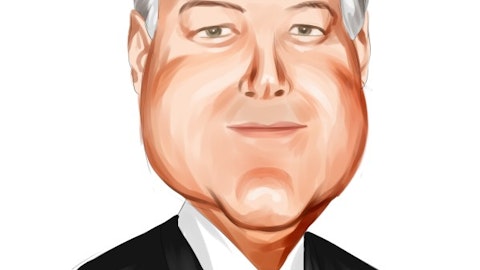Jonathan Komp: Jonathan, if I could just follow-up on the first quarter results. It looked like a pretty solid bottom line EBIT upside quarter relative to the revenue upside. So could you just, and sorry if I missed this, share any more details on the profitability flow through that you saw? And would you extrapolate any of those observations to the full year or is it just too small of a quarter to impact the full year view at all?
Jonathan Sinclair: So I think — it is a small quarter, but nevertheless, the momentum and the narrative around it is positive and that’s very much how we’d like to start the year. We were pleased with the performance, we’ve got — we found some cost efficiency in the business as the quarters progressed and that’s been helpful to the bottom line for sure. And with that level of comp growth at these sorts of gross margins, inevitably there’s a profit flow through, through from that and we’re very pleased with it. But it is a small quarter and therefore, we feel that it’s appropriate at this point to reiterate full year guidance rather than do anything else in the light of it, but it’s set us up well. I think I draw attention to the gross margins being slightly ahead. I think the comp growth is comfortable and positive. I think we’ve got a good landscape at this point.
Jonathan Komp: And then one follow-up I had just on inventory. Could you maybe share a little bit more, you touched on this, but just share a little more on what you’re thinking. If you could quantify some of the production cuts you’re making, either the magnitude or the duration or both? And as we think forward about the costing of the inventory that you produce, is there any sort of future concerns about lower utilization impacting your cost of goods or anything like that? Just more color on the inventory moves you’re making.
Jonathan Sinclair: I mean, if I can sort of take it to its natural consequence and say, are we worried about where the gross margin’s tracking there, we’re not and then let me back up into that. So that means that what we’re doing is we are putting proportionately less of our production in Canada, which is, call it, round sums, three quarters, 80% of what we buy and make. We’re putting proportionately less of that with our third parties and more of it through our own facilities. And actually what that does is that produces our overhead leverage. And that addresses the fact therefore that if you’re making slightly less, you don’t see cost growth and therefore margin dilution coming out of it, that’s one part of it. Second part is — and we’ve got less overheads, because we’ve got one less facility.
And so if you take that facility out, which is let’s say 12%, one eighth of the number of facilities. Then in reality you’ve sort of created a further tailwind there. So we’re not concerned about that. It still means that we — I mean we’ve got ample inventory to meet our needs. So it’s very aligned with our expectations of revenue as mentioned in the guidance ranges. So we feel pretty good about that. I think we feel like we’ve got the right framework coming into place now that helps us grow inventory at or below the rate of revenue growth in the longer run. And as I said this year, staying relatively flat to last year.
Operator: And our next question comes from the line of Ike Boruchow from Wells Fargo.
Ike Boruchow: I guess my question is on the geographic performance. So another quarter of Canada, well outpacing the US. Maybe just talk about the dynamics in both markets, how are you expecting this trend to play out for the remainder of the year? And then is this more a function of you guys outperforming in your Canadian market or underperforming in the US, is it both? Just trying to understand a little bit more geographically in North America?
Carrie Baker: The US experienced healthy growth. So I mean, when you look at the numbers, it’s up 15% year-over-year. It’s — obviously that strengthens our belief in our long term strategy. We do still feel like we’re early in that market, many more stores to open, many more brand — consumers to reach when you look at our brand awareness opportunity. I think Jonathan mentioned earlier, we have seen traction with women there, which is great. That is a big market for us in order to improve that mix back up to levels where we see other luxury players achieving. When you look at Canada, I mean, of course it’s our home market. We would expect it to be healthy, strong. There’s the highest awareness here. It is also a strong tourism market.




